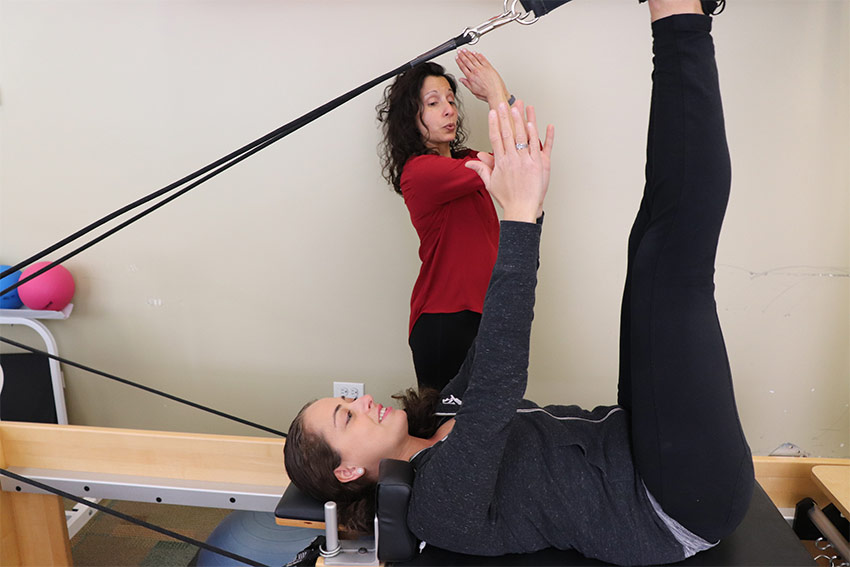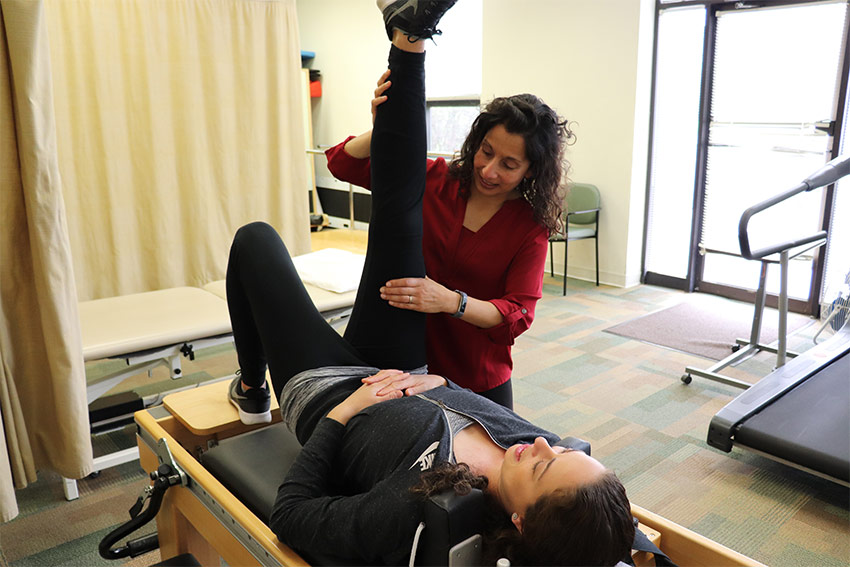Two thirds of women who’ve been pregnant experience this muscle problem
May 11, 2018
Could you have it?

Diastasis rectus abdominis (DRA) is a condition in which the two sides of the abdominal muscle separate. This can happen during the third trimester of pregnancy and it can be identified by a healthcare professional with a simple test.
“The diastasis recti can be found when you can place more than two fingers in between the abdominals,” explains Northwest Community Healthcare (NCH) Pelvic Floor Physical Therapist Kesuri Sethuraman, who works at the NCH Buffalo Grove Immediate Care Center. “The rectus abdominis is the muscle that meets near your belly button line.”
Symptoms
According to the American Physical Therapy Association (APTA), symptoms of DRA include:
- A visible and palpable (detected by touch) separation of the rectus abdominis muscle
- Feelings of flabbiness in the abdominal muscles
- Pelvic-floor muscle dysfunction that causes urinary or bowel problems (incontinence, leakage, constipation)
- Low back, pelvic or hip pain
- Poor posture
- Feeling weak through the midsection
- Sexual pain
The problem may not always be detected during pregnancy, but often is noticed postpartum, generally at a woman’s six-week checkup.
Women are usually complaining of back pain and hip pain with incontinence,” Sethuraman says. “They’ll do a pelvic exam and they’ll check out their abdominal area to see if there is a separation.”
Francesca Faso, a 31-year-old mother of two, didn’t realize she had DRA until she’d been working out for several months after having her second baby. As it turns out, doing crunches and V-sits was exacerbating the problem, resulting in abdominal and back pain.
“I noticed I had a protruding tummy that looked like I was three months pregnant all the time,” she recalled, adding that a friend at a party told her about DRA and encouraged her to talk to her doctor.
NCH Medical Group Family Medicine Physician Nurit Crystal, M.D. diagnosed Faso with DRA.
For patients like Faso, physical therapy is recommended to see if strengthening the muscle is appropriate. There are certain exercises that are better for such patients to strengthen the abdominals, and they do not include sit-ups or crunches. An abdominal binder may be recommended to keep the muscles closer together for strengthening. Surgery also may be a consideration.
“A physician may be afraid that a hernia (an organ or other tissue from your stomach area that can poke out through your abdominal tissue) might occur,” Sethuraman says.
NCH provides specialized physical therapy programs including women’s and men’s pelvic floor therapy at two locations to help. Sethuraman sees pre- and post-pregnancy patients and those who are recovering from hysterectomy, bladder reconstruction surgery and prostatectomies.
Treatment
A variety of methods are used to correct DRA.
“Initially, we use our biofeedback machine to help strength our pelvic floor muscles,” Sethuraman says. “These are a group of muscles and bones that need to be strengthened and stretched properly to function for proper bladder and bowel habits.”
The machine signals if muscles are weak or too tight. “From that, we develop an exercise program,” she says.
During treatment, patients are taught how to exercise at home and how to do exercises in the clinic while hooked up to the machine.
“After a C-section or hysterectomy, we may need to do myofascial release on scar tissue so muscles can contract and relax properly,” Sethuraman explains.
After it was recommended to Faso to work with a physical therapist specializing in women’s health, she made an appointment with Sethuraman. She began treatments in January and by the end of April, her pain was gone and her muscles were corrected.
“I had visited with a plastic surgeon because I thought I needed my abs reconstructed,” Faso says. “At one point, I couldn’t even vacuum or pick up my son. Now I can do all of that.”
Can DRA be prevented?
Unfortunately, according to the APTA, there is nothing that can be done to prevent DRA. “If you do develop DRA, the earlier you see a physical therapist, the faster you will be on the road to less pain and improved function,” the APTA website states.
“I see so many women coming to me sometimes 10 and 12 years later, and they say, ‘I just haven’t gotten rid of this baby pooch,'” Sethuraman says.”It’s not fat. It’s the separation of the abdominal muscles and the inner abdominal contents pushing through. It can be tissue lining, it could be an organ, or another muscle group.”
Good news

No matter how many years you have had DRA, it still can be corrected. Physical therapists can help strengthen the muscles, decrease the separation and reduce low back pain, hip pain and incontinence. Quality of life can be restored after the core is strengthened because patients have better control over their bladder and they’re no longer leaking. Significantly marked improvement usually happens after eight to 10 physical therapy visits.
“People limit where they go, their social activities, and their vacations,” Sethuraman says. “Physical therapy can also allow you to get back to high intensity exercises and activities. It brings function back.”
Faso is back to doing all of her normal activities, including housework and lifting her children.
“I’m working out again and I know what workouts I’m supposed to do and what not to do,” she says. “I’ve learned so much. I feel like it’s been a life change.”
Think you have it?
See your physician to ask if you have DRA. A doctor can diagnose and refer you to a physical therapist. For more information, call the NCH Buffalo Grove Immediate Care Center, 15 South McHenry Road, at 847-459-6100 or the NCH Rolling Meadows Outpatient Center, 3300 Kirchoff Road, at 847-618-3880.